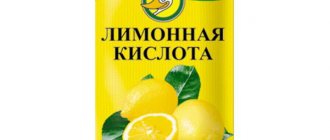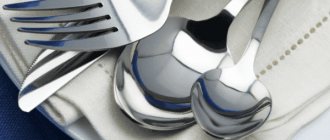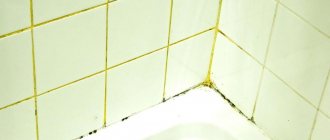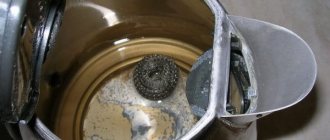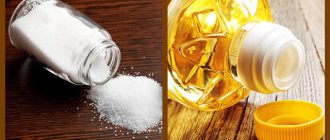The internal surfaces of the shower cabin are in daily contact with water and shower products. It would seem that under such conditions the walls, doors and pans simply must sparkle clean, because thanks to constant “irrigation” the dirt does not have time to settle anywhere and gain a foothold.
But in reality, we get a completely different effect: the more often water procedures are carried out in the shower stall, the faster limescale appears on glass, acrylic, plastic and tiles.
Limescale is a frequent “guest” in shower stalls. Photo by Matthew (source: flickr.com)
From the article you will learn how to clean a shower stall from limescale and how often you should clean it. We'll tell you why multi-layered solid gray or yellow deposits appear on wet surfaces, and what to do to prevent this.
What causes soap stains and limescale deposits?
Even if tap water meets the standards, it contains mineral salts. After a shower, water droplets remain on the glass surface. If they are not wiped off immediately, they dry out: the moisture evaporates, but the sodium and calcium remain in place, forming unsightly white marks.
Prevention of limescale deposits on shower glass
It will not be possible to completely prevent contamination, but you can save yourself from frequent cleaning with the help of simple means.
- After taking a shower, wait until all the water has drained and wipe off any remaining drops with a dry cloth. The cabin will remain clean and there will be no deposits.
- Ventilate the shower: ideally, it should be left open until completely dry. This simple method will also prevent mold from occurring.
- If forced ventilation is installed in the bathroom, cleaning will have to be done less often.
- Treat glass joints and contact areas with plastic, ceramics, and metal with protective compounds. They have a hydrophobic coating, which results in much less sediment.
- When rinsing the shower after yourself, do not use water that is too hot. After it, the adhesion of calcium, iron and sodium to the glass surface becomes stronger, and it is more difficult to wash off whitish traces than after a cold rinse.
Prevention of soap stains
Preventing the appearance of soap marks is as easy as shelling pears - switch to using shower gel or cream.
Choose beauty products that are quickly washed off the body. They have a special composition with high sliding properties. It will help avoid soap stains - caps of foam will remain on the door and walls, which are completely washed off when rinsing. If you don’t want to change your usual products to new ones, after each shower, do a quick cleaning of the surfaces with a rubber scraper. This takes 1-2 minutes and prevents the appearance of a white residue.
Preventive treatment of glass panels with a mixture of ammonia and water (a spoon per liter) once every 2 weeks will help reduce the interval between general cleanings.
Souvenirs
Wooden Pinocchio
Pinocchio is a symbol of Italy, sold in every souvenir stall. It costs a penny (up to 4.5 €, depending on the size), and is very cute. Suitable as a souvenir for friends, acquaintances or colleagues if the budget does not allow more.
Pinocchio is the Italian brother of our Pinocchio.
venecian mask
The Venetian mask is the perfect souvenir for role-playing game lovers (okay, you can just hang it on the wall). Mass-produced plastic masks are quite cheap (under 10 €). There are ceramic ones that are more expensive (from 30 €), and there are also luxury ones that Venetian masters will paint especially for you (prices for such masks start from 100 €). Choose who you are - the devil, the plague doctor or the crazy empress. Well, if you can, check out the carnival; in 2021 it will be held from February 16 to March 5.
The list can be continued endlessly, but we talked about the most important things. What’s nice is that in Italy there are things that will suit both the tightest and almost empty wallets.
What are water-repellent glass coatings and why are they needed?
The most effective prevention, which does not require extra effort to maintain cleanliness, is the application of a hydrophobic coating during the production of the product. It repels lime deposits and detergent residues, prevents the formation of plaque and makes everyday work much easier for the housewife. This is an additional option offered by leading manufacturers, including.
In addition, there are water-repellent products for shower glass for home use. Their composition is reminiscent of those aerosols that are applied to car mirrors for better visibility in bad weather. Fluorine-containing compounds create an “Anti-drop” effect. They do not allow water flows to linger in the form of drops, so until the water repellent is completely washed off, almost no plaque is formed.
How to apply a water-repellent coating: step-by-step instructions
The surface must be thoroughly washed, especially joints and seams.- Wipe with a dry cloth or wait until it dries naturally.
- Degrease with alcohol, ammonia or a special degreaser.
- Apply a hydrophobic glass cleaner to a non-woven fiber cloth. Treat the shower stall with it.
- Remove the matte “film” that appears by polishing movements using microfiber.
- Having done everything according to the rules, you will receive protection for an average of 2-3 months.
Important condition! If the shower room is below +10°C during treatment, the product will not fix.
Using Melamine Sponge
If there are no modern cleaning products in the house, no soda, no vinegar, then you can use a melamine sponge, with which you can easily get rid of limescale on the walls and chrome parts of the shower stall.
With its help you can easily remove the following types of contaminants without any detergents:
- soapy white stains;
- traces of fat;
- rust spots;
- as well as limescale.
Simply moisten the edge of the sponge a little in warm water and rub the stained area in a circular motion, then wash the area with a clean cloth and water.
How to remove plaque from shower glass
The tips listed above will reduce the need for thorough cleaning of the cabin to once a week.
But you still have to do some general cleaning. The easiest way to remove stains is with a steam generator. Even a small mobile model will do. It will soften the plaque, but will not completely remove it; additional devices and products will be needed. For example, a rubber scraper, which is used for washing windows, will help out.
Rough sponges or metal floats are prohibited - glass will corrode when used. Small scratches form on it, which deprive certain areas of their shine, plus plaque and dirt get deeper into the microcracks.
The best way to clean your shower is:
- soft non-woven napkins;
- microfiber cloths;
- melamine sponge.
Pallet washing
The cabin trays are not noticeable until you actually take a shower. Therefore, they are often ignored in the process of daily care. As a result, a hard coating forms on them and mold develops.
In order to wash the pallet well, you need to know the features of working with the material from which it is made.
Acrylic
Such products are easily scratched, which eliminates the use of powder products and hard brushes. The best option is to use special products for acrylic.
If the situation is not very bad, wipe the surface with a weak solution of citric acid (instead of 20 grams per glass, use 10). It will remove both plaque and mold.
In cases where the contamination is firmly embedded in the surface, a repair kit for acrylic will help. Its main elements: fine sandpaper and a special restoring compound. The procedure is as follows:
- Sandpaper is used to process a contaminated area, for example one in which limescale or mold is firmly ingrained;
- The cleaned area is treated with a restoring paste;
- After it dries, the shower can be used again.
The main thing in this process is to pay attention to the color of the composition.
Enameled pallets
It is also not recommended to scratch such products, but this is more difficult to do than with acrylic. Therefore, some abrasives can be used here. For example, toothpaste or tooth powder can remove stains well.
Simply apply the paste (or diluted powder) to the problem area and leave for 10 minutes. Then, rinse with water.
The advantage of enamel is its resistance to aggressive chemicals, which allows you to easily wash the enamel tray with a strong solution of citric acid, vinegar or alcohol.
Ceramic tile
This is the most unpretentious material that can be washed with almost anything. The only difficulty is the seams. They should be handled carefully but carefully. On the one hand, this is where dirt accumulates and the first signs of mold appear. On the other hand, scrubbing too vigorously can damage the seam.
The best option is regular cleaning with mild liquid products using a cloth or sponge. For particularly heavy plaque, you can treat it with a vinegar solution or citric acid.
To reliably remove mold, you can apply chlorine bleach to the seams and leave for 10-15 minutes, then rinse.
How to remove stains from shower glass
Those who prefer traditional folk recipes for cleaning the house can use the same life hacks for the cabin as for cleaning windows and mirrors. The main thing is that the cleaning compositions are in the form of liquids or sprays. A creamy or mushy texture will work, but not a powder.
- White vinegar 6% (1 tbsp per 1 glass of water). You can pour it into a container with a spray bottle or moisten microfiber with the resulting solution.
- Citric acid (200 ml sachet of hot water). To remove plaque, apply the mixture and leave for 15 minutes.
- Ammonia (20 ml per 1 glass of water). This recipe gives the glass a brilliant shine, but has a pungent odor.
- Pharmacy hydrogen peroxide. Moisten a cloth with it, wipe it and wash it off after 10 minutes.
- Alcohol / Vodka. They need to be sprayed and wiped with a non-woven cloth.
Video
To understand in more detail the nuances of cleaning the booth, watch the following videos:
Young mother, wife and part-time freelancer. Being a lawyer by training, I am accustomed to collecting and providing the most complete and reliable information. Constantly improves in the professional field and strives for personal growth and development.
Found a mistake? Select the text with the mouse and click:
Threads made of gold and silver, which were used to embroider clothes in the old days, are called gimp. To obtain them, the metal wire was pulled for a long time with pliers to the required fineness. This is where the expression “to drag out the rigmarole” came from - “to do long, monotonous work” or “to delay the completion of a task.”
Before removing various stains from clothing, you need to find out how safe the selected solvent is for the fabric itself. It is applied in a small amount to an inconspicuous area of the item from the inside out for 5-10 minutes. If the material retains its structure and color, you can move on to stains.
If your favorite things show the first signs of gestation in the form of untidy pellets, you can get rid of them using a special machine - a shaver. It quickly and effectively shaves off clumps of fabric fibers and returns things to their proper appearance.
Fresh lemon is not only suitable for tea: clean dirt from the surface of an acrylic bath by rubbing with half a cut citrus, or quickly wash the microwave by placing a container of water and lemon slices in it for 8-10 minutes at maximum power. The softened dirt can simply be wiped off with a sponge.
The easiest way to remove scale and carbon deposits from the soleplate of the iron is with table salt. Pour a thick layer of salt onto the paper, heat the iron to maximum and run the iron over the salt bed several times, applying light pressure.
The habit of using an automatic washing machine “sparingly” can lead to the appearance of an unpleasant odor in it. Washing at temperatures below 60℃ and short rinses allow fungi and bacteria from dirty clothes to remain on internal surfaces and actively multiply.
The dishwasher cleans more than just plates and cups. You can load it with plastic toys, glass lamp shades and even dirty vegetables, such as potatoes, but only without using detergents.
There are special traps to combat moths. The sticky layer with which they are covered contains female pheromones that attract males. By sticking to the trap, they are eliminated from the reproduction process, which leads to a decrease in the moth population.
Stretch ceilings made of PVC film can withstand from 70 to 120 liters of water per 1 m2 of their area (depending on the size of the ceiling, the degree of its tension and the quality of the film). So you don’t have to worry about leaks from neighbors above.
Source
Special household products for cleaning shower glass
If you don’t believe in folk recipes or want to save time, use store-bought products. They contain substances that effectively remove all types of contaminants, are adapted to the properties of the glass sheet and do not leave streaks behind. Cillit Bang Power Cleaner, LOCPlus, Clin “Windows and Glass”, Cif “Ultrafast”, Mr. Muscle with ammonia, etc.
Allergy sufferers, families with children and the elderly, as well as anyone who cares about their health are recommended to clean using natural household chemicals without harmful components. Similar options can be found in the brands Levrana, Weleda, Botavikos, Ecover, Organic People, Bio Mio, Wonder Lab, etc.
Safety rules when cleaning plaque
The shower stall is an enclosed space.
Even if glass panels and screens do not reach the ceiling, bathroom space is limited. Care must be taken not to inhale fumes from aggressive cleaning agents. Remember that even if you are completely healthy now, cumulative allergies may develop over time. To avoid this, do not neglect safety precautions when cleaning surfaces from plaque.
- Use a household respirator.
- Wear rubber gloves on your hands.
- Leave the door to the room open during treatment.
- If your shower room has windows, open them.
- Use forced ventilation.
- Do not use products containing high chlorine content.
- Do not use hot water: steam combined with chemical fumes will quickly lead to illness or fainting.
***
Now you know how to clean shower glass, and how to clean much less frequently. A properly selected arsenal of care products will not only help cope with dirt, but also keep glass structures in their original form: transparent, shiny and new.
Stages of cleaning a shower stall
The process of cleaning a shower stall can be divided into several successive stages. First, we prepare ourselves mentally and gather our strength. The next step is to prepare tools and detergents, taking into account the materials to be processed and the degree of their contamination. Don’t forget about personal protective equipment: hand gloves, and when using cleaning products with a strong, persistent odor and surfactants, use a respirator and safety glasses.
Bath and shower cleaning chemicals require careful use.
Next, we conditionally divide the booth into zones, in the sequence in which we will wash them:
- Chrome surfaces, taps, flexible hose, shower diffuser.
- Surfaces of the ceiling and side panels.
- Glass entrance door or plastic on curtains.
- Pallet.
Do not forget that you are working in a confined space with high humidity and the use of chemicals, so you should take care of ventilation or good ventilation.
It is important to pay attention to prevention, daily care and cleaning of the shower stall


